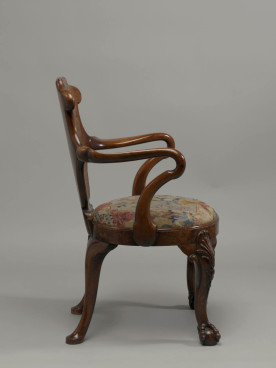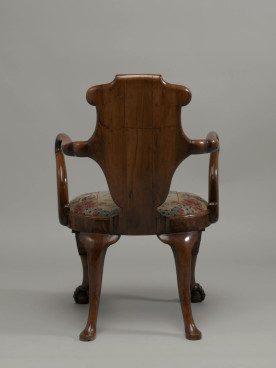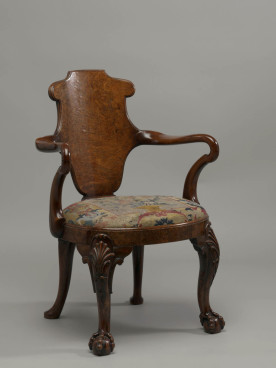Armchair, c.1827
Yew, now with 18th-century needlework
This chair is a copy of a familiar design of an eighteenth-century dressing chair. It is attributed to Gillow & Co.
Adam Bowett Catalogue (19/08/2012)
Description
A yew wood armchair, c.1830. The cartouche-shaped back is veneered with highly figured burr veneer, between ‘shepherd’s crook’ arms. The oval slip-seat is covered with 18th century needlework and raised on shell-carved cabriole forelegs with claw feet, and plain cabriole back legs.
Dimensions
H: 36” (91cm) Seat height: 17” (43 cm) W: 24 ½ “ (62cm) D: 21” (54cm)
Designer / Maker
Attributed to Gillows of Lancaster
Materials
Yew and yew veneer, oak.
Dating criteria
The shaped back and shell-carved cabriole legs with claw feet suggest a date of c.1735, but this type of chair was also produced in the early 19th century. See additional remarks below.
Construction
Back, arms and legs are of solid yew, with burr veneer to the front face of the back. The seat frame is oak, made in four curved sections with half-lapped joints at 2, 4, 8 and 10 o’clock. The joints are secured by screws. The show face of the rails is veneered with burr yew and finished on the top edge with a yew ovolo moulding. The legs are either tenoned or dovetailed through the half-lap to secure the joint. The legs have applied shaped brackets to either side and are reinforced with shaped oak blocks behind. The arms are constructed in two parts; the lower part is tenoned into the outside of the seat rail, the upper is screwed and plugged into the back. The joint between the two is a mortise-and-tenon. The back is made with three vertically-oriented yew boards, butt-jointed and fixed into the seat rail with a wide dovetail, reinforced with plugged screws. The construction of the drop-in seat is conjectural since it is completely enclosed by upholstery.
Marks or stamps
The inside of the seat rails is marked I to IIII in Roman numerals, corresponding to the separate components.
Condition
Very good, with little sign of damage. There has been some movement in the joints between upper and lower arm sections; splits to the arms at junction with back; some movement of veneers in back; shrinkage to veneers and mouldings on seat rails; There are indications that the back left leg has been re-fixed, and a screw is just visible beneath on edge of the supporting block.
Additional remarks
The extraordinarily good condition of this chair suggests it is not 18th century. This surmise is strengthened by anomalous details of construction; the tops of the legs do not show through the seat rails as they do on most 18th century chairs. Further, the numbering of the rails does not conform to known 18th century practise, nor does the use of screws to secure the seat rail joints. On the other hand, the screws are obviously not modern, which suggests the chair was not made later than c.1840.
The most likely maker of the chair is the firm of Gillows. A drawing in the Estimate Sketch Book for 13 June 1827 shows an identical chair described as ‘Old English’, made for Dallam Tower near Milnethorpe, Lancashire. This was made in yew, with oak rails, just as the present example. Other chairs in oak, walnut, mahogany and elm have been recorded, with slight differences in the carving of the feet, probably because carved by different craftsmen. The design is obviously based on early Georgian dressing chairs with their low, escutcheon-shaped backs and ‘shepherd’s crook’ arms, while the foreleg is modelled on a common Georgian design.
However, this model of chair certainly existed in the 18th century. A walnut example currently (September 2012) in stock with Apter Fredericks of London makes an interesting comparison. The design is identical, but the construction and materials are different. In particular, the seat rails are of solid walnut, and the tops of the legs show on the upper face of the rails in the usual 18th century manner. This chair also has abundant evidence of long and heavy use.
It is likely that these chairs have been mistaken for 18th century originals for many years. Percival Griffiths had this model, illustrated in R. W. Symonds, English Furniture Charles II to George II, p. 121, fig. 93. Another illustrated in H. Cescinsky, ‘The Old World House’. Vol. II, 1924, p. 18.
One sold at Christie’s New York, February 1980, Lot. 203.
One exhibited Northern Hospital, 25 Park Lane, London, 1931 (in catalogue as collection of Mrs. H Pears)
Slightly different model exhibited at Grosvenor House Antiques Fair, June 1958, p. 56.
Another in the collection of Sir Willliam Plender illustrated in R. W. Symonds, ‘Furniture in the collection of Lord Plender’, December 1931, fig. VIII.
References
Susan Stuart, Gillows of Lancaster and London, 1730-1840, 2 Vols.,Woodbridge (2008), I, p. 232 & pl. 225.
Provenance
Purchased from G. Randall Inc., October 1990












